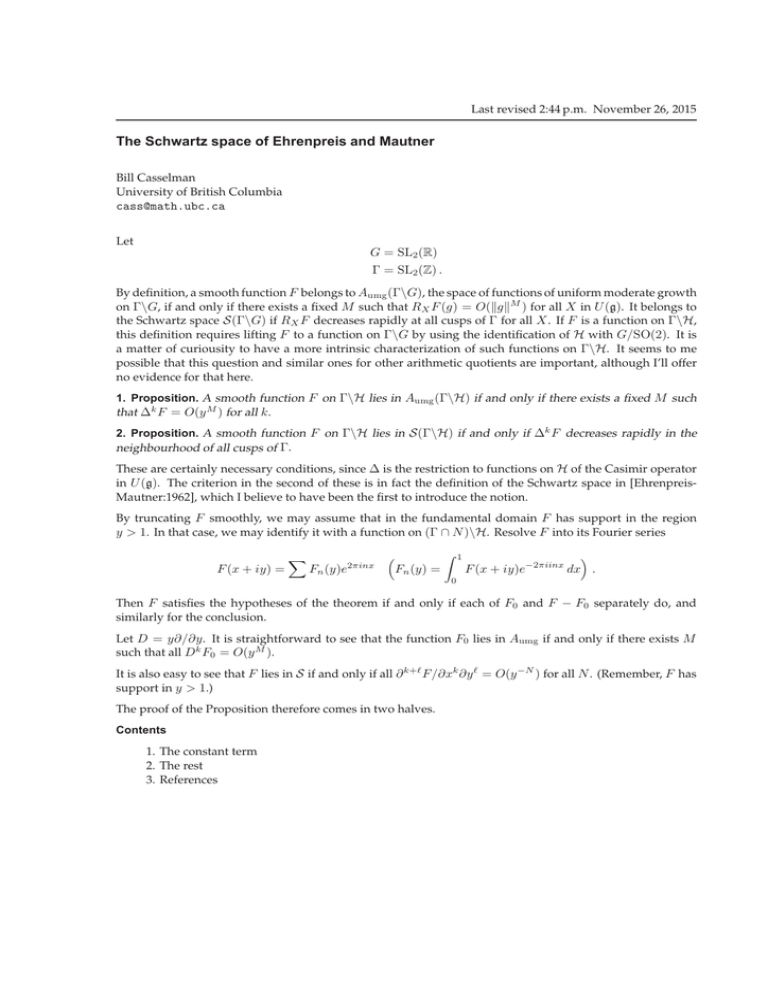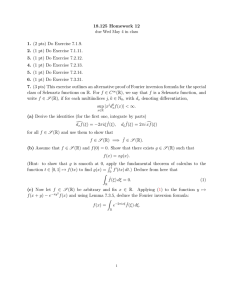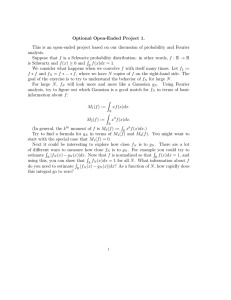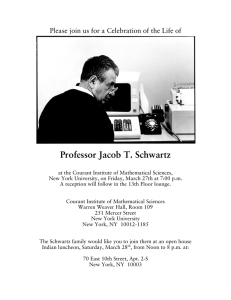The Schwartz space of Ehrenpreis and Mautner
advertisement

Last revised 2:44 p.m. November 26, 2015 The Schwartz space of Ehrenpreis and Mautner Bill Casselman University of British Columbia cass@math.ubc.ca Let G = SL2 (R) Γ = SL2 (Z) . By definition, a smooth function F belongs to Aumg (Γ\G), the space of functions of uniform moderate growth on Γ\G, if and only if there exists a fixed M such that RX F (g) = O(kgkM ) for all X in U (g). It belongs to the Schwartz space S(Γ\G) if RX F decreases rapidly at all cusps of Γ for all X . If F is a function on Γ\H, this definition requires lifting F to a function on Γ\G by using the identification of H with G/SO(2). It is a matter of curiousity to have a more intrinsic characterization of such functions on Γ\H. It seems to me possible that this question and similar ones for other arithmetic quotients are important, although I’ll offer no evidence for that here. 1. Proposition. A smooth function F on Γ\H lies in Aumg (Γ\H) if and only if there exists a fixed M such that ∆k F = O(y M ) for all k . 2. Proposition. A smooth function F on Γ\H lies in S(Γ\H) if and only if ∆k F decreases rapidly in the neighbourhood of all cusps of Γ. These are certainly necessary conditions, since ∆ is the restriction to functions on H of the Casimir operator in U (g). The criterion in the second of these is in fact the definition of the Schwartz space in [EhrenpreisMautner:1962], which I believe to have been the first to introduce the notion. By truncating F smoothly, we may assume that in the fundamental domain F has support in the region y > 1. In that case, we may identify it with a function on (Γ ∩ N )\H. Resolve F into its Fourier series F (x + iy) = X Fn (y)e 2πinx Z Fn (y) = 0 1 F (x + iy)e−2πiinx dx . Then F satisfies the hypotheses of the theorem if and only if each of F0 and F − F0 separately do, and similarly for the conclusion. Let D = y∂/∂y . It is straightforward to see that the function F0 lies in Aumg if and only if there exists M such that all Dk F0 = O(y M ). It is also easy to see that F lies in S if and only if all ∂ k+ℓ F/∂xk ∂y ℓ = O(y −N ) for all N . (Remember, F has support in y > 1.) The proof of the Proposition therefore comes in two halves. Contents 1. The constant term 2. The rest 3. References The Schwartz space of Ehrenpreis and Mautner 2 1. The constant term I’ll deal with the constant term first. 1.1. Proposition. Suppose that F is a smooth function on (0, ∞) with support in y > 1 such that for some fixed M all ∆k F = O(y M ). Then all Dk F = O(y M ); as well. Proof. Suppose that F = F0 . |F (y)| ≤ C0 y M , (∆F ) = y 2 F ′′ (y) ≤ C2 y M . 1.2. Lemma. Suppose F (y) and y 2 F ′′ (y) are both O(y M ), and of support near y = ∞. Then yF ′ (y) = O(y M ) as well. Proof. The idea is to reduce it to a variant of a well known lemma due originally to Landau: 1.3. Lemma. If g(t) = O(eµt ), then so also is g ′′ (t) = O(eµt ) g ′ (t) = O(eµt ) . Proof of Landau’s Lemma. g(t) − g(t − ε) = εg ′ (t) + (ε2 /2)g ′′ (θ1 ) (t − ε < θ1 < t) g(t + ε) − g(t) = εf ′ (t) + (ε2 /2)g ′′ (θ2 ) (t < θ1 < t + ε) g(t + ε) − g(t − ε) = 2εf ′ (t) + (ε2 /2) g ′′ (θ1 ) + g ′′ (θ2 ) 2εf ′ (t) = g(t + ε) − g(t − ε) − (ε2 /2) g ′′ (θ1 ) + g ′′ (θ2 ) 2ε|f ′ (t)| ≤ P eµ(t+ε) + eµ(t−ε) + Q(ε2 /2) eµθ1 + eµθ2 ≤ P eµt eµε + e−µε + (ε2 /2)Qeµt eµε + 1 ≤ P eµt eµε + 1 + (ε2 /2)Qeµt eµε + 1 µε P Qε e +1 + |f ′ (t)/eµt | ≤ 2 ε 2 for all ε > 0. The function of ε E(ε) = eµε + 1 2 P Qε + ε 2 approaches ∞ near 0 and also as ε → ∞, and somewhere in between takes a minimum positive value Emin . Thus for all t |f ′ (t)| ≤ Emin eµt . This concludes the proof of the two lemmas. Applied to all the ∆k F in turn these imply that all Dk F0 = O(y M ), and this in turn implies that F0 is of uniform moderate growth or rapid decrease, depending on the assumption on the ∆k F . Q.E.D.We start with F (y) = O(y m ), We can write y 2 F ′′ (y) = O(y M ) . y 2 F ′′ = (D2 − D)F = (D − 1/2)2 F − 1/4F if D = y∂/∂y , and then deduce (D − 1/2)2 F = O(y M ) . The Schwartz space of Ehrenpreis and Mautner 3 If we set G(y) = y λ F (y), then DG = y λ DF + λy λ F = y λ (D + λ)G D2 G = λy λ (D + λ)F + y λ D(D + λ)F = y λ (D + λ)2 F . Set λ = −1/2, so G = y −1/2 F (y) = O(y M−1/2 ) D2 G = y −1/2 (D − 1/2)2 F (y) = O(y M−1/2 ) If we change the independent variable to y = et we get equations G(t) = O(e(M−1/2)t ) G′′ (t) = O(e(M−1/2)t ) 2. The rest Now I’ll deal with the rest of F . 2.1. Proposition. Suppose F to be a smooth function on Γ∩N \H with support in y > 1 and all ∆k F = O(y M ). If F0 = 0 then all the ∂ k+ℓ Φ/∂xk ∂y ℓ = O(y −N ) for all N . Proof. I’ll start off by looking at the the individual terms in the Fourier expansion. We have (∆F )n (y) = y 2 Fn′′ (y) − 4π 2 n2 Fn (y) and we may assume n 6= 0. If ∆k F = O(y M ) for all k then so is ∆k Fn (y) = O(y M ) for all k . 2.2. Proposition. Let F (y) = O(y M ) be a smooth function on R with support on (1, ∞), and suppose that for some λ ≥ 1 y 2 (F ′′ − λ2 F ) ≤ Cy M . Then F ≤ (CCM /λ)y M−2 for some constant depending only on M . P Since the λ we are concerned with are the 4π 2 n2 and the series n>0 1/n2 < ∞, this imples the bound we want on F itself. Proof. Let G(y) = y 2 (F ′′ − λ2 F ). Since F has support on (1, ∞) so does G. Since E(x) = −e−λ|x| /2λ satisfies the distributional differential equation E ′′ − λ2 E = δ0 an easy calculation tells us that F (y) = c+ eλy + c− e−λy − 1 2λ Z ∞ e−λ|x−y|G(y) dy . 1 Since G(y) = O(y M ) an easy calculation tells us that the integral is of moderate growth, and therefore since F is of moderate growth the coefficient c+ has to vanish. Thus F (y) = c− e −λy 1 − 2λ Z 1 ∞ e−λ|x−y| G(y) dy . The Schwartz space of Ehrenpreis and Mautner 4 Since F (0) = 0 1 c− = 2λ and hence e−λy F (y) = 2λ Z ∞ e −λx 1 Z ∞ e−λx G(x) dx 1 1 G(x) dx − 2λ For the moment, let IN = Z Z ∞ e−λ|x−y| G(x) dx . 1 ∞ e−λx xN dx . 1 Integration by parts and an easy estimate gives IN ≤ 1 (N ≤ −2) N e−λ + IN −1 λ λ e−λ N N (N − 1) · · · (N − n) N (N − 1) = 1+ ++ + λ λ λ2 λn+1 IN = e−λ (1 + N + N (N − 1) + · · · + N (N − 1) · · · (N − n)) λ e−λ = EN λ ≤ EN /e = if n = ⌈N + 1⌉, keeping in mind that λ ≥ 1. Thus the first term above is bounded by CEM−2 e−λy . 2λe The second term can be broken up into two parts: ∞ Z e−λ|x−y| G(x) dx = 1 Z y e−λ(y−x) G(x) dx + ∞ e−λ(x−y) G(x) dx y 1 ≤C Z Z y e−λ(y−x) xM−2 dx + C 1 Z ∞ e−λ(x−y) xM−2 dx . y For the first of these integrals: Z 1 y e −λ(y−x) M−2 x y Z M − 2 y −λ(y−x) M−3 e x dx − λ 1 1 Z y M−2 − e−λ(y−1) M − 2 y −λ(y−x) M−3 = − e x dx λ λ 1 e−λ(y−x) xM−2 dx = λ y M−2 − 1 y M−2 − e−λ(y−1) + λ λ 2y M−2 ≤ , λ ≤ which implies that the term is bounded by Cy M−2 y M−2 ≤ . 2 λ λ The Schwartz space of Ehrenpreis and Mautner For the second: Z ∞ 5 e−λ(x−y) xM−2 dx = Z ∞ ∞ = Z y e−λs (s + y)M−2 ds 0 e−λs (s + y)m−2 ds (m = ⌈M ⌉) . 0 To this last expression we can apply the binomial theorem and the estimate of the first integral to see that this ∗ M−2 second term is at most CCM y /λ. So now we know that F itself is rapidly decreasing. It remains to show that all its partial derivatives are also rapidly decreasing. I leave this as an exercise! Q.E.D. 3. References 1. F. Brauer and J. Nohel, Ordinary differential equations, Benjamin, 1967. 2. Bill Casselman, ‘Automorphic forms and a Hodge theory for congruence subgroups of SL(Z)’, pp. 103–140 in Lie group representations II, Lecture Notes in Mathematics 1041, 1984. 3. J. J. Duistermaat, Fourier integral operators, published originally in 1973 as lecture notes by the Courant Institute. Published later by Birkhäuser, 1996. 4. L. Ehrenpreis and F. I. Mautner, ‘The Fourier transform on semi-simple Lie groups III’, Transactions of the American mathematical Society 90 (1959), 431–484. 5. E. T. Whittaker and G. N. Watson, Modern Analysis, Cambridge, 1952.








